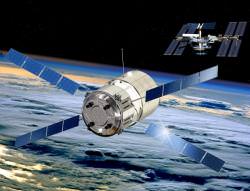Problems struck the brand new ESA Automatic Transfer Vehicle (A T V) at 260km above the Earth shortly after it was launched into orbit on Sunday. Seven of the 28 attitude control jets and a main engine shut down unexpectedly, forcing the craft to switch to backup systems. The panic has now subsided as commands sent from mission control fixed the glitch and the thrusters switched back online…
Although the ATV has to wait around for NASA’s STS-123 mission to complete after it un-docks with the International Space Station (ISS) in a few days time, “Jules Verne” still has some manouvering to do. After its launch on board an Ariane-5 rocket from South America on March 9th, all systems appeared to be functioning normally. However, problems struck as the ATV began to thrust its way from its original 260km orbit to the ISS orbit of 340km.
ATV project manager John Ellwood gave a statement in Kourou as the troubles surfaced, but appeared undaunted by the problem:
“We’re sitting and thinking about this; we’re not in a rush to do manoeuvres […] We have the 10-day margin before we need to start going into [demonstration manoeuvre] days at the end of the month.”
After all, the ATV has over three weeks to stay in orbit and wait for Space Shuttle Endeavor to leave on March 24th and then dock at the station on April 3rd. Mission engineers had a lot of time on their side. It appears that they only needed a few hours to iron out the problem; all systems appear to be functioning well as of March 12th after new commands were transmitted from mission control.
It appears the problem started after data was received on the ground indicating there was a large difference in pressure between the oxidiser and the fuel entering the ATV’s complex network of pipes and valves connecting the fuel tanks and thrusters. Reacting to the warning, the chains of pipes were shut down, stopping fuel from entering the thrusters. The problem was solved by slowly turning on fuel supplies to each thruster and one of the main engines. The fix appears to be a total success.
The ATV will now carry out practice manoeuvres to prepare it for the ISS docking sequence at the start of next month.
Source: BBC


Hello,
The links to you podcasts seem to be broken? I get err 404???
You probably know this but all podcast are on astronomy cast’s website at.
astronomycast.com
Keep up the great work guys!!!
informative and decent aricle. Thanks Ian.
Most new systems seem to come up with their own little quirks. Kudos to the Euros for fixing it quickly. I would have been mildly suprised at a flawless performance.
-chanting the mantra over and over-
…Economies of scale, economies of scale, economies of scale…
Props to the ESA.
ATV-1 “Jules Verne” actually launched on the night of March 8-9, not March 11.
To Thorny:
Thanks for that – corrected now, quoted the STS-123 launch incorrectly 🙂
Cheers, Ian
If you want to hear a reader’s feedback 🙂 , I rate this post for four from five. Detailed info, but I just have to go to that damn google to find the missed parts. Thank you, anyway!